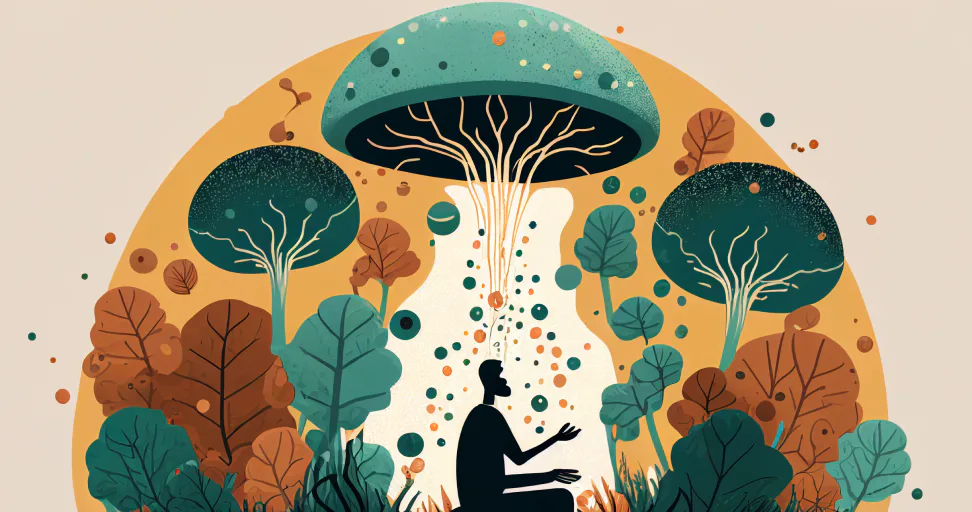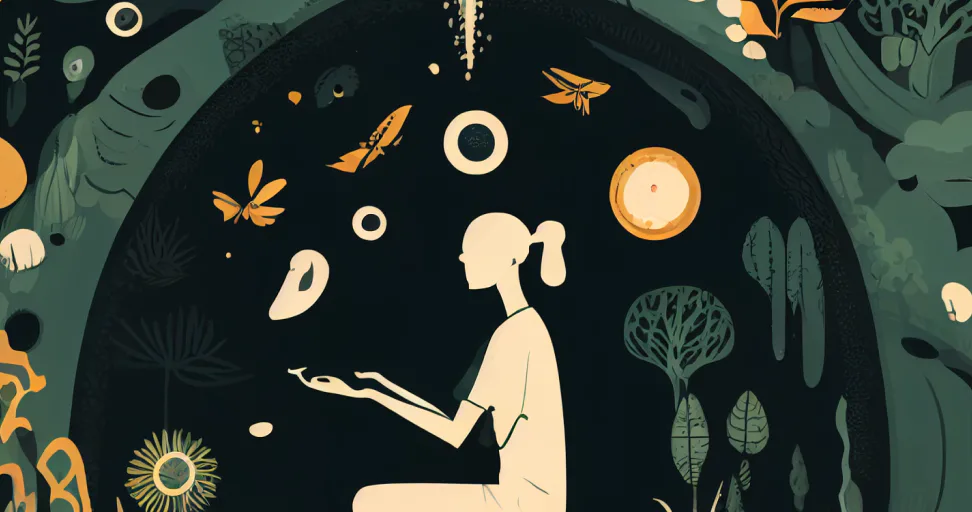Humans have done an outstanding job at entertaining and educating ourselves. It’s not just that there’s too much content on the internet to sift through. There’s also too much high-quality content. The list of amazing podcasts, blogs, books, tv shows, articles, art projects, and new musicians to follow is seemingly endless. It can easily be overwhelming. There’s simply too much awesome stuff, and we don’t have enough attention to process it all.
This is ironic because our attention system evolved to address this very sort of challenge. Without an attention system, our evolutionary ancestors would have faced a fatal problem. There was just too much information coming in from their sensory inputs, and too many alternative ways of interpreting it. Without some way of prioritizing and processing this information, our ancestors would have been completely overwhelmed by the simplest of situations.
That’s what our attention systems do. They help us prioritize what is central to survival (someone coming at you with a spear) and ignore the unimportant information (the rate at which the grass is growing). How does your brain know what is important and unimportant? It never knows for sure, but it gets good at guessing through evolution and learning. For example, we don’t need to learn that unexplained loud noises often deserve attention, but we do need to learn to pay attention to our rear-view mirrors while we drive. And so it is because we’re equipped with an attention system that prioritizes things for us that we’re able to navigate an incredibly complex world with our finite brains.
Super Stimuli and Its Effects on the Brain
However, getting good at navigating this smorgasbord of stimuli eventually created a new problem: we humans learned how to create super stimuli. A super stimulus is anything that hijacks your attentional system and causes you to pay excessive attention to it. Common examples include things like junk food, cable news, addictive drugs, pornography, and video games. All of that high-quality content on the internet – podcasts, blog posts, music, books, etc. – are also built to be good at grabbing your attention. And it can be exhausting.

Indeed, we know that overstimulation can be quite damaging to our well-being. Having our attentional systems constantly overwhelmed causes them to misbehave: our brains start prioritizing the wrong bits and ignoring the good bits. One study found that having an unread email sitting in your inbox while concentrating on a task can reduce your effective IQ by 10 points. More generally, we may miss much of the beauty and precious detail in our lives just because we’re trying to process all the stimuli.(1)
This could lead to something known as sensory overload. Essentially, our minds may become so overwhelmed with superfluous information that they begin to shut down. To reduce the hurricane of stimuli, our brains might start to ignore things. Some of which could be extremely important.
So what can we do? Clearly, the super stimuli are not going away anytime soon. If anything, they’re going to become even more enticing as social media algorithms get better at hacking our attention systems. So whatever the solution is, it must somehow involve us reclaiming our attention from the distraction of super stimuli. This is where meditation and psychedelics may be of tremendous help – particularly in their combination.
How Meditation and Psychedelics Can Help
Let’s start with meditation. While there are different meditative practices out there, one thing common to many is that they involve attention training. For example, in vipassana meditation, we pay attention to our thoughts and sensations without letting our attention get caught up in them. For example, if you notice the arising of a thought – say, “Oh, I need to listen to that latest meditation podcast!” – you just notice that thought, gently resist the temptation to react to it, and then allow it to pass away on its own accord. If you consistently follow this meditation practice, you become more mindful over time, become less reactive to all the stimuli you encounter. This, in turn, allows your mind to open up and return to its original nature.
One benefit of this opening up of the mind is that it reconnects us with the simple beauty of our sensory experiences: the feel of the air on our skin, the smell of the flowers we have on our table, and so on. At the same time, this opening of the mind also reconnects us with ourselves. As Shunryū Suzuki put it:(2)
“When you are you, you see things as they are, and you become one with your surroundings. There is your true self. There you have true practice… “
―Shunryū Suzuki, Zen Mind, Beginner’s Mind
Psychedelics and Their Impact on the Mind
Psychedelics, when used safely and appropriately, may have a similar effect on the mind. An essential part of the psychedelic experience is the “set and setting.” These terms describe two distinct factors you need to consider before beginning your journey: “set” (our mindset, intentions, and emotional state) and “setting” (your environment, the people you have with you, and the things you can access). In essence, meditation can be an infinitely valuable part of creating a healthy “set” or mindset.
We’re still discovering how psychedelics work on the brain, but one leading theory says that psychedelics break open and flatten the brain’s salience maps and open up the sensory floodgates that the brain has learned over time to shut down. The result is that the brain’s usual patterns of processing information become freer, and the mind becomes open to more possibilities. One becomes more and more aware of one’s various thoughts and sensations. Indeed, a growing number of studies and trials indicate that psychedelics can induce immediate and long-lasting increases in mindfulness. As George Harrison put it in his 1987 Rolling Stone Magazine Interview, “psychedelics open a door in your mind that you didn’t know was there.”(3, 4, 5)

While the effects of psychedelics can be rather different from those of meditation and also much more variable, there are some similarities. In particular, psychedelics have the capacity to reconnect people to their surroundings and true selves. For example, one study found that people often report feeling more connected to their environment, especially nature:(6)
“Before I enjoyed nature, now I feel part of it. Before I was looking at it as a thing, like TV or a painting. You’re part of it, there’s no separation or distinction, you are it,” said one participant.
And two other studies found that people often report discovering a more authentic experience of themselves:(7, 8)
“[It was] me revealing myself, like actually showing myself to the world. This is who I am, this is who I really am.”
As with the practice of meditation, the anxious overstimulation we associate with modern technology isn’t as present in these states – even though one is far more connected and more aware of one’s surroundings than in regular life.

Combining Meditation and Psychedelics
So, why combine meditation and psychedelics? You can combine meditation and psychedelics to complement each other and help make up for each other’s drawbacks. Psychedelics may be useful in helping to kick-start or reinvigorate one’s meditation practice by showing the way – by opening the doors of perception. Indeed, a recent survey found that exposure to psychedelics was associated with an increased likelihood of meditation practice. And meditation can be useful by helping to bring more stability and clarity to one’s experiences with psychedelics. Two studies have indicated that sustained meditative practice can enhance the benefits of psychedelics. A beautiful film, Descending the Mountain, was made about the latter.(9, 10, 11, 12, 13)
Several schools of meditation can pair well with psychedelics (possibly hundreds, but here is a much shorter and hopefully easy-to-follow list).(14)
They Include:
This common style of meditation involves sustained attention on specific things. For example, you can bring your attention inward and focus on things like breathing. Or you can focus on an external object like a tree or candle.
This style of meditation places importance on developing compassion and love for yourself and others. You gradually focus on empathetic feelings starting with yourself, then extending out. LKM may not be the most optimal style for dealing with overstimulation. Still, it does work extraordinarily well with the increased empathy derived from psychedelics like psilocybin and MDMA (commonly known as molly or ecstasy).
Mantra recitation is part of the focused attention school of meditation. It involves the creation of repetitious sounds or phrases that are either spoken or held within the mind. This style of meditation is known for its ability to trigger similar neural activity as psychedelics and can help you maintain a deep sense of inner focus.
It can be argued that all schools of meditation are a form of mindfulness. However, here, we are speaking of simply allowing your mind to cease wandering by focusing on being in the moment. By allowing yourself to slip into a relaxed but present mental state, you can step away from the nonsense of your (often) overstimulated day. To do so, you can focus on your breathing, maintain a particular posture, or keep certain landscape features locked into your view (these are just a few examples).
The intentional use of psychedelics to help open and relax the mind can be extremely rewarding. This is because psychedelics can allow our minds to disengage from repetitive behaviors (think endless scrolling on your phone, flicking through different streaming apps and shows) and allow us to return our attention to ourselves. Bringing psychedelic usage into your meditation practice can aid in freeing your mind from an overload of stimuli.(15)
In general, there are many reasons to expect meditation and psychedelics to have a rich set of synergistic and complementary effects.(15)

Broadly speaking, the sequence of events might go as follows. Our minds are flooded with competing sets of stimuli every day. From an evolutionary perspective, our brains are designed to shut down what is irrelevant, and focus on what is salient to our survival. With the floodgates of super stimuli open, we may begin to shut out the very things that bring us joy, such as the simple beauty of the way the light streams through our windows. Psychedelics can open the doors to that very kind of visual or felt sensation, releasing what has been shut down or hidden from us in our mind’s attempt to manage our day-to-day lives. Meditation can help to prepare our minds for this experience by calming and centering us, and can, conversely, support us in grounding the wisdom of what we’ve learned during a psychedelic journey. Mindfulness can bring us back from the expansive nature of psychedelic visions and center us in the now, the present, the very essence of this reality.(16)
With the combination of psychedelics and meditation, two doors of perception open at once: one to the world and one to ourselves. By opening them, we’re able to remain grounded, remember what is truly important, maintain a clear perception of our environment, and thereby avoid the problem of overstimulation.
This article contains expert opinion, and recommendations based on the writer’s personal and professional experience, as well as their knowledge of psychedelics.
This material is not intended as a replacement or substitute for any legal or medical advice. Always consult a medical professional about your health needs. Psychedelics are widely illegal in the United States, and readers should always be informed about local, state, and federal regulations regarding psychedelics or other drugs.
- Hofman, M. A. (2014, March 10). Evolution of the human brain: When bigger is better. Frontiers. Retrieved March 22, 2023, from https://www.frontiersin.org/articles/10.3389/fnana.2014.00015/full
- Gashi, L., Sandberg, S., & Pederson, W. (2020, October 17). Making “bad trips” good: How users of psychedelics narratively transform challenging trips into valuable experiences. International Journal of Drug Policy. Retrieved March 22, 2023, from https://www.sciencedirect.com/science/article/pii/S0955395920303352
- Orsolini, L., Papanti, G. D., De Berardis, D., Guirguis, A., Corkery, J. M., & Schifano, F. (2017, November 3). The “Endless Trip” among the NPS users: Psychopathology and Psychopharmacology in the hallucinogen-persisting perception disorder. A systematic review. Frontiers. Retrieved March 22, 2023, from https://www.frontiersin.org/articles/10.3389/fpsyt.2017.00240/full
- B;, E. (n.d.). Set, setting, and Matrix. Journal of psychoactive drugs. Retrieved March 22, 2023, from https://pubmed.ncbi.nlm.nih.gov/9250949/
- Takeuchi, H., Taki, Y., Asano, K., Asano, M., Sassa, Y., Yokota, S., Kotozaki, Y., Nouchi, R., & Kawashima, R. (2018, November). Impact of frequency of internet use on development of brain structures and verbal intelligence: Longitudinal Analyses. Human brain mapping. Retrieved March 22, 2023, from https://www.ncbi.nlm.nih.gov/pmc/articles/PMC6866412/
- Suzuki, S. (2018). Zen Mind, beginner’s mind: Informal talks on zen meditation and Practice. Amazon. Retrieved March 22, 2023, from https://www.amazon.com/Zen-Mind-Beginners-Informal-Meditation/dp/1590308492
- Carhart-Harris, R. L., & Friston, K. J. (2019, July 1). Rebus and the anarchic brain: Toward a unified model of the brain action of psychedelics. Pharmacological Reviews. Retrieved March 22, 2023, from https://pharmrev.aspetjournals.org/content/71/3/316
- Radakovic, C., Radakovic, R., Peryer, G., & Geere, J.-A. (2022, September 15). Psychedelics and mindfulness: A systematic review and meta-analysis. AKJournals. Retrieved March 22, 2023, from https://akjournals.com/view/journals/2054/6/2/article-p137.xml
- Watts, R., Day, C., & Carhart-Harris, R. (2017, June 19). Patients’ accounts of increased “connectedness … – sage journals. Sage Journals. Retrieved March 22, 2023, from https://journals.sagepub.com/doi/10.1177/0022167817709585
- Noorani , T., Garcia-Romeu, A., & Johnson, M. (2018, June 25). Psychedelic therapy for Smoking Cessation: Qualitative … – sage journals. Sage Journals. Retrieved March 22, 2023, from https://journals.sagepub.com/doi/10.1177/0269881118780612
- Belser, A., Agin-Liebes, G., & Ross, S. (2017, April 28). Patient experiences of psilocybin-assisted … – sage journals. Retrieved March 22, 2023, from https://journals.sagepub.com/doi/10.1177/0022167817706884
- Huxley, A. (1994). The doors of perception. Amazon. Retrieved March 22, 2023, from https://www.amazon.com/Doors-Perception-Heaven-Hell/dp/0061729078
- Simpson, O., & Goldberg, S. (n.d.). Linkages between psychedelics and meditation in a population-based sample in the United States. Taylor & Francis. Retrieved March 22, 2023, from https://www.tandfonline.com/doi/full/10.1080/02791072.2021.2022816
- Griffiths, R., Johnson, M., & Klinedinst, M. (2017, October 11). Psilocybin-occasioned mystical-type experience in combination with meditation and other spiritual practices produces enduring positive changes in psychological functioning and in trait measures of prosocial attitudes and behaviors. Sage Journals. Retrieved March 22, 2023, from https://journals.sagepub.com/doi/10.1177/0269881117731279
- Descending the mountain a tender film exploring psilocybin and the nature of consciousness. Descending the Mountain. (2021, October 25). Retrieved March 22, 2023, from https://descendingthemountain.org
- Wolff, M., Evens, R., Mertens, L. J., Koslowski, M., Betzler, F., Gründer, G., & Jungaberle, H. (2020, January 3). Learning to let go: A cognitive-behavioral model of how psychedelic therapy promotes acceptance. Frontiers. Retrieved March 22, 2023, from https://www.frontiersin.org/articles/10.3389/fpsyt.2020.00005/full
 Dr. Aidan Lyon
Dr. Aidan Lyon David Connell
David Connell


